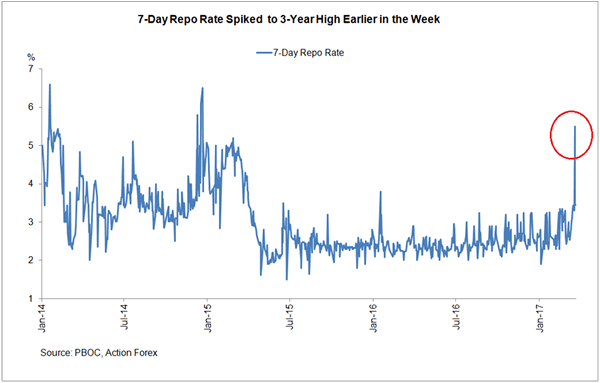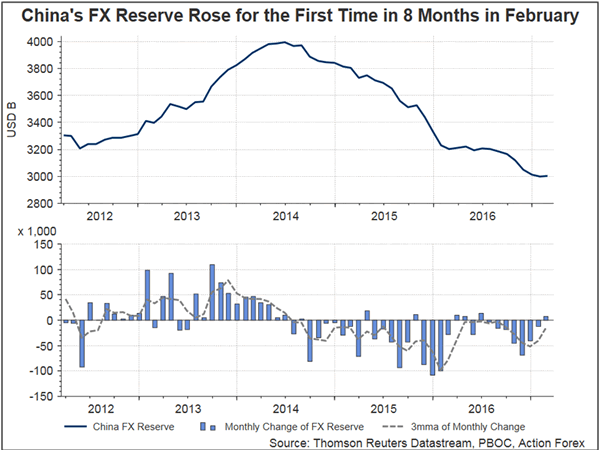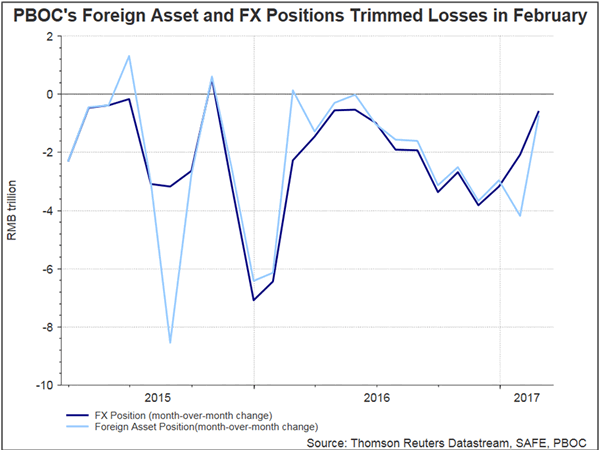China’s financial system continues to display fragility and liquidity squeeze. China’s 7-day repo rate jumped to 5.5% (close), the highest level since late 2014, on Tuesday, followed by PBOC’s injection of RMB 80-90B to the market on Wednesday as some small banks failed to repay debts in the interbank market. Less than a week ago, PBOC raised a range of short-term and medium-term interest rates to reduce financial risks, thought to be a response to Fed funds rate hike. Interbank rates should remain volatile over the coming week, ahead of PBOC’s quarterly macro-prudential assessment in late March. Although recent data suggested that the problem of capital outflow eased in February, ongoing interest rate normalization in the US would prolong China’s capital outflow problem, sustaining the challenges facing China in the implementation of its monetary policy.

As a gauge of liquidity in China, the sudden uptick in the 7-day repo is alarming. Hovering around mid-3% level these two days, the rate jumped to as high of 9.5% earlier in Tuesday before settling at 5.5% for the day. This has overshot the underlying trend of interbank tightening and has raised concerns over China’s tight credit condition. Less than a week ago, PBOC raised a range of short-term and medium-term interest rates last Thursday, following the Fed’s rate hike of +25 bps. The reverse repo rates for 7 days, 14 days and 28 days, increased +10 bps to 2.45% 2.6% and 2.75% for 7 day, 14 days and 28 days, respectively. The rates for medium lending facility (MLF) for 6 months and 1 year also added +10 bps to 3.05% and +3.2%, respectively. It was estimated that the move had eliminated RMB120B from the market. The central bank affirmed that the move aimed at deleveraging, "deflating bubbles", and risk prevention. While PBOC would prefer to continue guiding an upward trend in interbank rates in order to curb bubbles and prevent risks in certain ‘risky’ areas (e.g. housing market), the implementation would be a cautious one as the market is obviously vulnerable to small increase in funding costs.
Recall that China’s FX reserve, rising for the first time in 8 months, added +US$ 6.9B to US$ 3.01 trillion in February. After adjusting for currency valuation effects, the reserves probably increased US$ 19-25B in the month. While this might be the first signal that China’s capital outflow problem has tamed, we suggested in our previous report that PBOC’s FX positions are insightful for a clearer outlook of China’s capital flow situation. The second chart below shows that China’s capital outflow problem indeed eased last month. The monthly change in total foreign assets position (including FX, gold and "other" foreign assets) is not subject to valuation effect and can be considered as PBOC’s cost of acquiring foreign assets. The change in FX position is most directly related to the central bank’s FX intervention. The changes in both positions rose to the levels not seen since mid-2016.


Part of the improvement can be attributed to one-off and seasonal factors. For instance, repatriation of unreported export proceeds might have affected the figure, while a shorter month in February had also reduced the time that the public could engage in capital flows. Nonetheless, government’s capital control measures have also played an important role. Indeed, the crackdown on outward M&A has led to declines in China’s outbound investment, by -39% y/y and -36% y/y in December and January respectively. The above-mentioned rate hikes have also helped retain capital. This is another rationale for PBOC to continue guiding interbank rates higher.

















